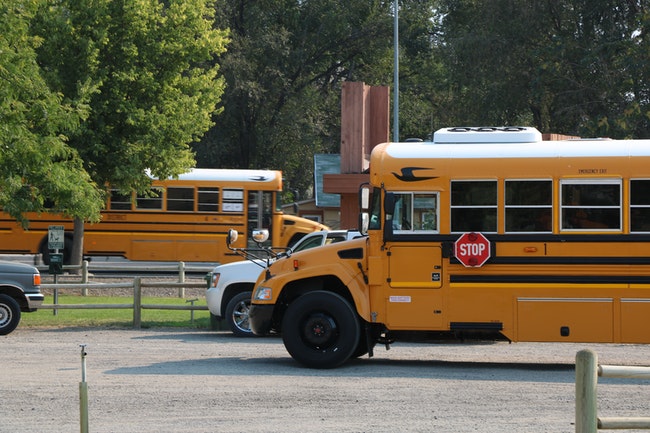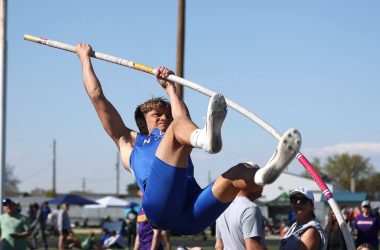
Harper School District buses unload students by Logan’s Market on Tuesday afternoon, Sept. 8. Only 10 students can be on each bus due to Covid precautions. (The Enterprise/Aidan McGloin)
Local school districts are making the most of special state rules to get students back into classrooms – at least for a few hours – while a full return to class for most schools is still weeks away at best.
The state Department of Education allows groups of 10 students to be taught in-person for no more than two hours a day, with no more than 250 students per school building for an entire week.
For a school with fewer than 250 students, that means every student can come to a class if the school district chooses.
Each of the 113 students at Harper Charter School chose to come for the instruction Monday through Thursday, said Ron Talbot, superintendent.
Elementary students study reading and math in the morning, and in the afternoon high school students alternate between math, English and 40-minute classes of either science, history or electives like automotive.
The students are excited to be seeing each other again, said Talbot.
“We’re just doing what we can to get kids here for as long as we can,” said Talbot.
That includes a transportation pain.
Each school bus can only hold 10 students under state mandates, leading Talbot to run six bus routes to get the elementary students on campus, then home, then get the high school students on campus, then home. In total, he runs 12 routes, six times the normal, along U.S. Highway 20.
The school is also offering access to the weight room and the volleyball courts after school for conditioning, which is allowed under the Oregon School Activities Association guidelines.
The students have been well-behaved, said Alicia Anderson, a first- and second-grade Harper teacher with 26 years at the school. They haven’t been playing with their masks, or moving between their distanced seats.
It’s the most unusual year to teach, said Anderson.
Half of the students who learn in-person study in the cafeteria, where Anderson uses the industrial-sized refrigerator as a whiteboard.
Anderson had to drastically slim down her lesson plans. Since Harper is opting to be focused on in-person lessons, she teaches the two hours a day in-person, then pre-records herself reading for 40 minutes. After that, it’s on the students to watch the video, and do homework assignments that Anderson uploaded. She’s then available for help in office hours in the afternoon.
Total instruction time is three hours, not the usual six, so she cut out lessons about artists or musicians she would usually showcase and shaves off the rest of her lesson plans.
She is assigning the same amount of homework as last year, she said.
It’s hard to cover everything she wants to cover, but she’s glad she got to teach in-person.
“I’m so excited that I get to see my students and work with them in the fall,” said Anderson.
The Nyssa School District is slowly building up its in-person program, and will begin offering English Language Learners sections this week, followed by bringing in students enrolled in the welding program, said Ryan Hawkins, assistant superintendent.
“We are not going to sacrifice safety for speed,” said Hawkins, who said they’re making sure they have enough thermometers and hand sanitizer stations before they open the classes.
At the Vale School District, students will be offered two hours of in-person help from teachers twice a week, said Alisha McBride, Vale School District superintendent.
The help will be offered from 8 a.m. to 10 a.m. Monday through Thursday, said McBride.
“It gives staff and students the opportunity to connect, something we are desperately in need of right now,” said McBride.
Students will be automatically enrolled in time slots with their teachers starting Monday, Sept. 14, said McBride, and they have the option to come or not since the instruction is optional.
Students at the middle and high school are enrolled in two virtual classes for the next nine weeks, and the in-person instruction will allow them time with their teacher.
That means students enrolled in welding or automotive can work in person.
“This limited in-person instruction is somewhat of a gift,” said McBride.
Vale Elementary School is lucky in that it’s made up of two separate buildings. Under the state’s guidelines, that means it can conduct classes for all students. If the school was only made of one building, they would only be able to teach 250 of their 366 students in a week, McBride confirmed with the Oregon Department of Education.
The Vale School District does not have the resources to bus all their students into school. Last year, the district bused 450 students, but that would require 45 routes under the current requirements.
“It’s impossible given the size of our district to provide transportation,” said McBride.
The Ontario School District is still focusing on starting distance learning, and has not begun planning limited in-person instruction.
PRIOR COVERAGE
From students: Jordan Valley schools adjusting, and glad to be back
Nyssa students go to class, at home
Malheur County educators share advice to keep kids engaged in long-distance schooling
News tip? Contact reporter Aidan McGloin at [email protected] or at 541-473-3377.
KEEP THE ENTERPRISE GOING AS OTHERS CLOSE…..
Reader support allows the Enterprise to provide in-depth, accurate reporting that otherwise would not get done. Keeping the community well informed is essential. SUBSCRIBE – $5 a month, automatically. DONATE – to provide additional support.




